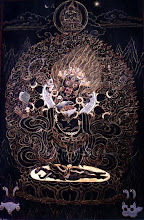L. Ron Hubbard was a pulp fiction writer of the 1940's, a man with an apparently charming personality and a knack for self-promotion. To those who knew him well, he was also paranoid, spiteful and cruel. He is regarded by his followers as a 20th century guru, to the rest of the world as perhaps the century's most successful fraud, the founder of the Church of Scientology, the pseudo-religion most commonly associated with actors Tom Cruise and John Travolta.

But you won't learn much about this in Hardeep Singh Kohli's mistitled 2006 film, The Beginner's Guide to L Ron Hubbard, which follows the presenter as he makes a foray into the practice of Scientology. The film is one of a three-part Beginner's Guide series in which celebrities live for a short time as members of traditionally non-English faiths, including Islam and Hinduism. Hardeep was an interesting choice for the Scientology project, a Scottish-raised Sikh with a degree in law and a career as a comedian and presenter. His humor, though, seems to be kept in check by his fear of being brainwashed, of his two week journey resulting in a scarred psyche.
It appears his adventure may end prematurely when the Church of Scientology takes offense at the program being hosted by a comedian and refuses a request for an introduction. What most viewers might not realize is that Scientology is practiced outside the official church by small groups loosely associated as The Freezone, and it is with them that Hardeep finds the opportunity to explore.
But he has to go to Russia to practice, a literal free zone beyond the reach of the church's army of lawyers. Along the way he chats with his apostate guide and tries reading one of Hubbard's introductory texts, finding that though he understands the words, the concepts remain elusive. It doesn't get much better when he finally arrives in Russia, where he has to work through a battery of training routines that don't seem to add up to a coherent practice. Until, that is, he finally undergoes auditing, Scientology's equivalent of psychoanalysis, when the long hours of practicing to stay focused on a subject, to clarify meaning, to speak with emotional honesty, are deployed in a one-on-one in which the auditor seeks to uncover a patient's points of psychological stress.
Hardeep admits to a strained relationship with a brother. After talking about it with the auditor, he feels lightheaded, relieved, like a weight has been lifted. Here he seems to have uncovered the appeal of Scientology, at least at the level practiced among initiates, a technique to enable the practitioner to be honest about his fear and pain. It is in the simplest sense an alternative form of therapy. Hardeep doesn't quite see this, preferring a more general (and perhaps incomplete) conclusion accepting Scientology's claims to improve lives.
Still, this is one of the more interesting documentaries on the group for providing an initiate's ground eye view, one that works both for and against Scientology. Hardeep's attempts to come to terms with the master's philosophy substantiates the initial impression you get that Hubbard in fact has none, that it is nothing but a bewildering arrangement of mirrors suggesting some kind of discernible pattern (if only you keep looking). But by sharing his own training experience he demonstrates what it is that draws people to the group, what motivates them to come back (only to find themselves later dangling like a fish at the end of a line).
If you ever wondered what it might be like to walk into a Scientology center and explore, watch this film before you go.
The 48 minute film is currently available for viewing at Google Video. Discussion of the film can be found in threads (here and here and here) at Operation Clambake, a website monitoring Scientology activities.
#































Two of my favorite things, laughing and Scientology. Looks really good, how did you find it?
ReplyDeleteLast week I was on a Scientology jag, exploring some of the offerings at Google video, and - voila! There it was. Have you ever been to a CoS center?
ReplyDelete